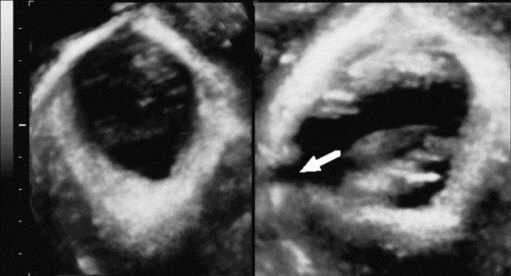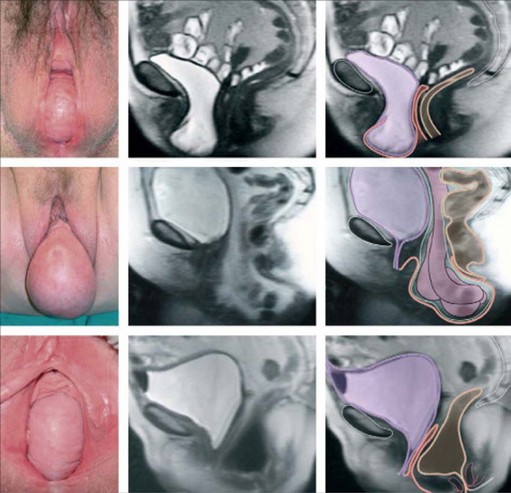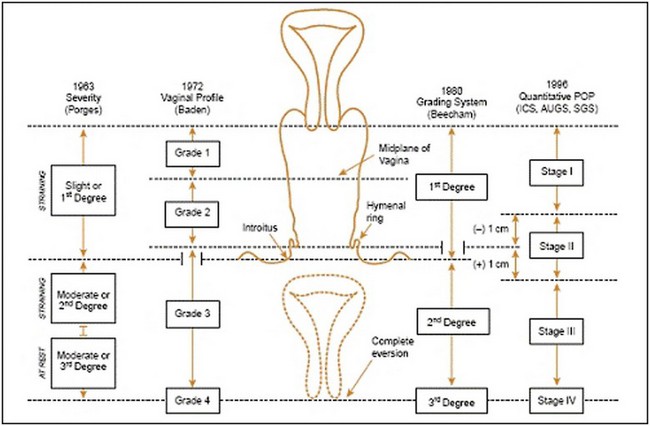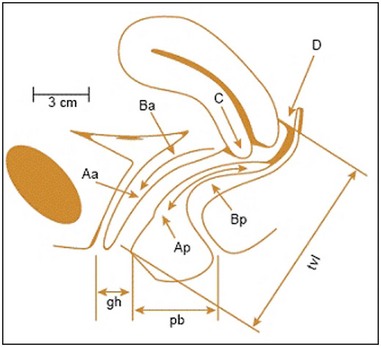CHAPTER 55 Pelvic organ prolapse
Prevalence
Pelvic organ prolapse is very common. In the Women’s Health Initiative (WHI), 41% of 27,342 women aged 50–79 years showed some degree of POP (Hendrix et al 2002, Figure 55.1). Indeed, with both life expectancy and rates of obesity increasing, the prevalence of POP is likely to rise. However, the majority of such women are symptom free and much of this prolapse is not considered clinically significant. Large cross-sectional studies have demonstrated rates of symptomatic POP of 3–11% (Tegerstedt et al 2005, Nygaard et al 2008, Fritel et al 2009). Women whose prolapse extends beyond the hymenal remnants are more likely to be symptomatic (Swift et al 2003). Although POP is rarely life threatening, it has a substantial impact on quality of life, such that 6.7% of women in the USA will undergo a surgical procedure for prolapse by 80 years of age (Olsen et al 1997).
Aetiology
The aetiology of POP is poorly understood, which is remarkable given the magnitude of the problem. Although multifactorial in nature, vaginal birth has emerged as the principal risk factor (Mant et al 1997). Avulsion injury to the levator ani during childbirth and, less commonly, pudendal neuropathy and fascial damage appear to be the most common causes (Dietz 2008a, Figure 55.2). Unsurprisingly, therefore, increasing parity, fetal macrosomia and perineal trauma increase the odds of subsequent POP, although the much-quoted link to instrumental vaginal delivery is not borne out in all studies (Uma et al 2005, Tegerstedt et al 2006).
Nulliparous women may also develop prolapse, and various non-obstetric aetiological factors have been identified (Miedel et al 2009). A number of reports, including the WHI, have demonstrated increasing rates of POP with advancing age (Hendrix et al 2002, Handa et al 2004), although a simple linear relationship is not universally accepted (Dietz 2008b). Some studies have shown an impact of ethnicity on POP, with lower rates of POP among Black women and higher rates among Hispanic women compared with White women (Hendrix et al 2002, Rortveit et al 2007). An association with body mass index (BMI) is generally agreed (Whitcomb et al 2009), and is of particular concern given the global rise in obesity. In addition, twin studies have demonstrated a clear genetic component to the disorder (Altman et al 2008), supported by stronger family histories among affected women (McLennan et al 2008).
The evidence directly linking hysterectomy and POP is not compelling and is potentially confounded by the indication for the original hysterectomy. Among 384 women undergoing surgery for POP/incontinence, 60% had a previous hysterectomy and/or pelvic floor repair, suggesting a potential aetiological role (Olsen et al 1997). Despite this, the cumulative probability of requiring a POP repair 20 years following hysterectomy for non-prolapse is only 0–2%, raising the possibility that it is the history of prolapse and not the hysterectomy per se which is the dominant risk factor (Blandon et al 2007). Finally, conditions associated with increased intra-abdominal pressure (constipation, cough, heavy lifting) are generally considered to be risk factors for prolapse (Rortveit et al 2007).
Classification
Management of POP is determined primarily by the findings on physical examination; thus, a standardized and reproducible classification system is crucial. Initially, POP is classified by vaginal compartment into (Figure 55.3):
The anterior compartment is the most common site of POP, although in most cases, there will be evidence of prolapse in more than a single compartment (Hendrix et al 2002). In addition to classifying POP by anatomical compartment, an assessment of prolapse severity (stage) is undertaken. A variety of systems to stage POP have been described (Figure 55.4). However, in 1996, the Pelvic Organ Prolapse Quantification (POP-Q) system was developed by consensus of international expert groups (Bump et al 1996). It is a more objective, site-specific system for staging pelvic support with proven inter- and intraobserver reliability (Hall et al 1996). The POP-Q system references nine vaginal points (two anterior, two posterior, two superior, two frontal and total vaginal length) to the plane of the hymen during Valsalva strain to create a ‘topographic’ map of the vagina (Figure 55.5). These anatomical points are measured following demonstration of the maximum extent of the prolapse to determine the stage. Typically, the nine-point findings are translated into an ordinal staging system (stage 0–IV) to aid comparative analyses and facilitate more practical communication (Figure 55.4).
Pelvic Anatomy
On each side of the pelvis, a dense layer of connective tissue, the endopelvic fascia, envelops the uterus and cervix and attaches to the pelvic sidewall. As well as providing support, the endopelvic fascia also serves as a neurovascular conduit and is composed of collagen, smooth muscle, blood vessels and nerves. In certain areas, thickened condensations of this fascia form pelvic ‘ligaments’ which add support. The clinically important ligaments include the uterosacral ligaments (extending laterally from the posterior cervix to the anterior sacrum), the cardinal ligaments (transverse cervical/Mackenrodt’s ligaments, extending from the lateral cervix and upper vagina to the pelvic sidewall) and the round ligament (extending from the uterine cornu to the labia majora as the superior part of the broad ligament) (Raizada and Mittal 2008).
DeLancey introduced the concept of three levels of connective tissue support in the anterior pelvis. Level I (apical vaginal) support is via the uterosacral/cardinal ligament complex, and damage at this level results in uterine/vaginal vault prolapse (DeLancey 1992). Level II (midvaginal) support is achieved via the endopelvic fascia and its lateral insertion into the white line. Level III (distal vaginal) support incorporates the endopelvic fascia anteriorly and the perineal body posteriorly. Anterior and posterior compartment prolapse result from damage to level II/III support, respectively. Although DeLancey’s system creates artificial divides in what is essentially a continuous connective tissue structure, it does aid understanding of how loss of support correlates with clinical findings, and is widely reproduced in the gynaecological literature.
Clinical Presentation
Patients who seek medical care have a wide range of symptoms (Table 55.1). Women frequently present with a sensation of ‘something coming down’ or of ‘something falling out of the vagina’. Other women may see or feel a vaginal bulge or they may complain of less specific herniation symptoms, such as pelvic pressure or heaviness. As might be expected, a visible vaginal bulge correlates better with objective evidence of POP on examination than the more general complaint of pelvic heaviness or discomfort (Miedel et al 2008).
Table 55.1 Common symptoms associated with pelvic organ prolapse
| Vaginal symptoms |
| Urinary symptoms |
| Bowel symptoms |
Urinary symptoms
Among 237 women with symptomatic POP, 87% reported frequency/urgency, 73% reported urinary incontinence and 50–60% reported symptoms of voiding dysfunction (Ellerkmann et al 2001). A complex relationship exists between POP and stress urinary incontinence, and may result from shared risk factors rather than a direct causal link (Smith and Appell 2005). In practice, many women present with both cystocele and stress incontinence, and loss of the anterior vaginal wall support is thought to contribute to urethral hypermobility and subsequent stress incontinence (DeLancey 2002). However, the relationship is not linear and some studies have demonstrated lower rates of stress leakage in more advanced POP (Yalcin et al 2001, Burrows et al 2004). This is likely due to a direct compressive effect or a urethral kinking mechanism, and is important given the risk of hidden or ‘occult’ stress incontinence manifesting once the prolapse is reduced (see ‘Investigation’ section). Interestingly, posterior vaginal wall prolapse has recently been linked to stress incontinence (Miedel et al 2008). More advanced POP can produce obstructive voiding symptoms or, rarely, urinary retention. The need to manually reduce a bulge to void is progressively linked to more severe POP (Burrows et al 2004, Miedel et al 2008). The relationship between POP and overactive bladder symptoms has not been studied as extensively. Analysis of 330 women undergoing surgery for POP or incontinence found that urgency/urge incontinence occurred more often in women with less advanced prolapse (Burrows et al 2004). Other studies, however, have shown a positive association between urge incontinence and both anterior and posterior compartment prolapse (Miedel et al 2008). This is supported by short-term improvements in overactive bladder symptoms following prolapse repair (Nguyen and Bhatia 2001, Digesu et al 2007).
Bowel symptoms
Bowel symptoms and difficulty with defaecation are common symptoms among women with POP. These include straining, sensation of incomplete emptying and the need to manually assist defaecation (digital pressure to the vagina or perineum). Among 280 women with symptomatic POP, almost three-quarters (73%) reported at least one bowel symptom (Miedel et al 2008). The most consistently reported prevalence of faecal incontinence associated with POP ranges from 14% to 19% (Jackson et al 1997, Burrows et al 2004, Jelovsek et al 2005, Miedel et al 2008). The extent of POP does not appear to predict bowel symptoms (Jelovsek et al 2005), although the need to manually assist defaecation has been associated with more severe prolapse (Burrows et al 2004). Much has been written about the relationship between posterior compartment prolapse and constipation, and it has been suggested that constipation contributes to the development of rectocele and vice versa. However, the exact nature of the association remains uncertain. It is notable that several studies have failed to identify a relationship between constipation and POP (Samuelsson et al 1999, Jelovsek et al 2005).
Sexual dysfunction
Sexual dysfunction is very common in women attending urogynaecology clinics (Pauls et al 2006), although it may not be volunteered due to patient embarrassment or poor history taking. Sexual satisfaction is a complex issue and studies examining the association between POP and sexual dysfunction have yielded conflicting results. Although high rates of satisfaction have been reported in women with POP (Barber et al 2002, Burrows et al 2004), other data have shown POP to have an adverse effect on sexual function (Rogers et al 2001, Novi et al 2005). It appears that women with POP are more likely to complain of problems with sexual function than those with urinary incontinence (Barber et al 2002). Weber found no differences in measures of sexual function in women with POP and incontinence compared with continent women without prolapse (Weber et al 1995). Furthermore, the benefits of pelvic floor surgical repair on sexual function have not been consistent (Thakar 2009).
Prediction of symptoms
Attempts have been made to correlate the severity (stage) of POP with the likely development of symptoms. Consistently strong correlations between increasing severity of POP and the development of symptoms have not been demonstrated (Burrows et al 2004). Many studies indicate a lower rate of stress incontinence in more severe anterior compartment prolapse. Miedel et al (2008) showed that most urinary and bowel symptoms associated with POP lack stage dependency, although there was correlation between a vaginal bulge and more advanced prolapse in all compartments. However, a large prospective study of 477 patients suggested that women whose prolapse extends beyond the hymenal remnants are more likely to be symptomatic (Swift et al 2003).
Physical examination
All women who present with symptoms consistent with POP should undergo a physical examination, including pelvic examination. Although some authorities advocate the need for physical examination in the standing position for all patients, use of the dorsal lithotomy position with Valsalva has been shown to be as good (Swift and Herring 1998). In practice, many clinicians examine women lying supine during resting and straining, and it is reasonable to reserve the standing position for women who feel that their prolapse is not being seen at its worst extent in that position (American College of Obstetricians and Gynecologists 2007). Conventionally, prolapse is examined while asking the woman to perform a Valsalva or cough stress test so that the maximum extent of the prolapse can be appreciated. A Sim’s speculum (or the posterior blade of a bivalve speculum) is inserted into the vagina to retract the posterior wall and allow visualization of the anterior wall; the extent of any prolapse is noted while the woman strains. The process is repeated for the posterior wall with the speculum retracting anteriorly. Sometimes, an anterior wall prolapse may be better appreciated with the woman in the left lateral position and her right hip flexed. Finally, the cervix or vaginal vault is assessed either through visualization or with gentle traction from a ring forceps, although, in practice, many women find the latter uncomfortable. Areas of bleeding/ulceration, which can be seen in prolapse extending past the introitus in particular, should be noted (Figure 55.6). Women with recurrent prolapse should have a meticulous examination to assess previous surgical repair and plan future management. Staging of the prolapse should be recorded for all compartments using the practitioner’s chosen method, although the POP-Q system is the internationally accepted standard (Figure 55.5, see ‘Classification’ section).
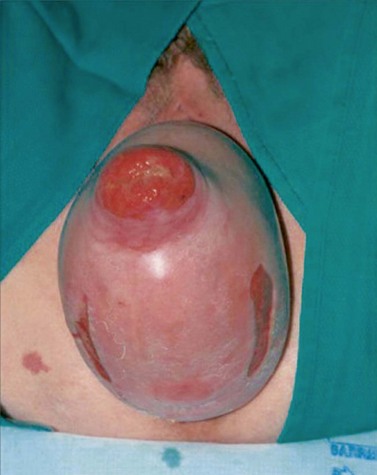
Figure 55.6 Complete uterovaginal prolapse. Note the linear erosions on the posterior vaginal mucosa.
Jelovsek JE, Maher C, Barber MD (2007) Pelvic organ prolapse. Lancet 369:1027–38.
In addition to staging POP, a number of other features of the physical examination are noteworthy. Abdominal palpation and a bimanual pelvic examination should be performed in these patients as, occasionally, a large pelvic mass, such as a fibroid uterus or ovarian mass, may be detected. Although routine rectal examination for all patients is unnecessary, it can be useful in defining a posterior compartment prolapse, particularly where there is suspicion of an enterocele (which can be felt between a thumb placed in the vagina and a finger placed in the rectum). In addition, it can be useful to look for stress urinary incontinence on provocation by asking the patient to cough, assuming the bladder has not been emptied recently. Furthermore, in cases of advanced anterior compartment prolapse in women who do not complain of urinary leakage, there is concern that prolapse reduction may unmask ‘occult’ stress incontinence. Therefore, a cough test following temporary reduction of the prolapse into a more anatomical position (manually or with a cotton swab or ring forceps) may be useful (Fatton 2009). In a large randomized trial, reduction using a cotton swab most closely reproduced postoperative status following sacrocolpopexy compared with other reduction techniques (Visco et al 2008). Finally, digital assessment of the strength of the patient’s pelvic floor muscle contraction is beneficial in women with concomitant stress urinary incontinence.
Investigation
The most contentious issue in the investigation of POP is the need for preoperative urodynamic testing. Women with POP without stress leakage have a 10–50% chance of developing de-novo (‘occult’) stress incontinence post repair (Fatton 2009). An anti-incontinence procedure may be performed concomitantly but will likely overtreat a proportion of women, and increases postoperative voiding problems and overactive bladder symptoms (de Tayrac et al 2004). Alternatively, a two-stage strategy can be adopted, where an interval continence procedure is reserved for patients with troubling stress urinary incontinence following prolapse repair. The use of preoperative urodynamics to better stratify patients into those who may or may not benefit from concomitant continence surgery has been suggested. However, there is little evidence that preoperative urodynamics improves the outcome of prolapse surgery (Roovers and Oelke 2007). The CARE (Colpopexy and Urinary Reduction Efforts) trial did show that women with POP and preoperative urodynamic stress incontinence during reduction testing had a higher rate of stress leak following abdominal sacrocolpopexy without the continence procedure. It is notable that even with optimal prolapse reduction during preoperative urodynamics (by cotton swab), one-third of women who were dry before surgery developed postoperative stress incontinence (Visco et al 2008).
Various radiographic modalities have been proposed to further define the extent of POP, although none are in mainstream clinical use. Dynamic magnetic resonance imaging (MRI) is the most commonly described technique (Law and Fielding 2008, Taylor 2009). Dynamic MRI offers excellent anatomical detail and allows visualization of all three compartments together (Figure 55.7), but is expensive and dispute remains over the appropriate radiological landmarks for staging POP (Broekhuis et al 2009). Transperineal ultrasound (TPUS), and increasingly three- and four-dimensional TPUS, have also been used in staging POP radiologically (Dietz 2004). Recently, moderate-to-good correlation was demonstrated between three-dimensional TPUS and defaecography (traditionally the gold standard investigation) in the assessment of posterior compartment prolapse (Steensma et al 2009). However, TPUS does not appear to be superior to clinical assessment of POP (Kluivers et al 2008
Stay updated, free articles. Join our Telegram channel

Full access? Get Clinical Tree



